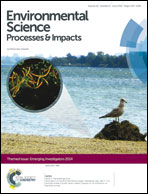Sorption behavior of heavy metals on poorly crystalline manganese oxides: roles of water conditions and light†
Abstract
The objective of this study was to determine the effects of solution properties and light on the metal uptake and release in a nanosized, poorly crystalline manganese oxide (δ-MnO2) system. The results from synthetic water matrices revealed that the aggregation state was strongly affected by ionic strength, Ca2+, and humic acid, and the particle aggregation subsequently changed the ability of δ-MnO2 to adsorb and sequester heavy metal ions (Cu(II)). The extent of Cu(II) uptake onto δ-MnO2 exhibited a negative correlation with the attachment efficiency value, which suggested that a lower sorption capacity could be achieved under aggregation-inducing conditions. Upon exposure to light, the adsorbed Cu(II) was released from the δ-MnO2 surface via photoinduced dissolution of MnO2. The concentration of Cu(II) desorbed was substantially higher when the humic acid was present together with Ca2+. The present investigation enables us to better understand the adsorption–desorption processes of heavy metals occurring at the MnO2–solution interface in response to common environmental stimuli.


 Please wait while we load your content...
Please wait while we load your content...